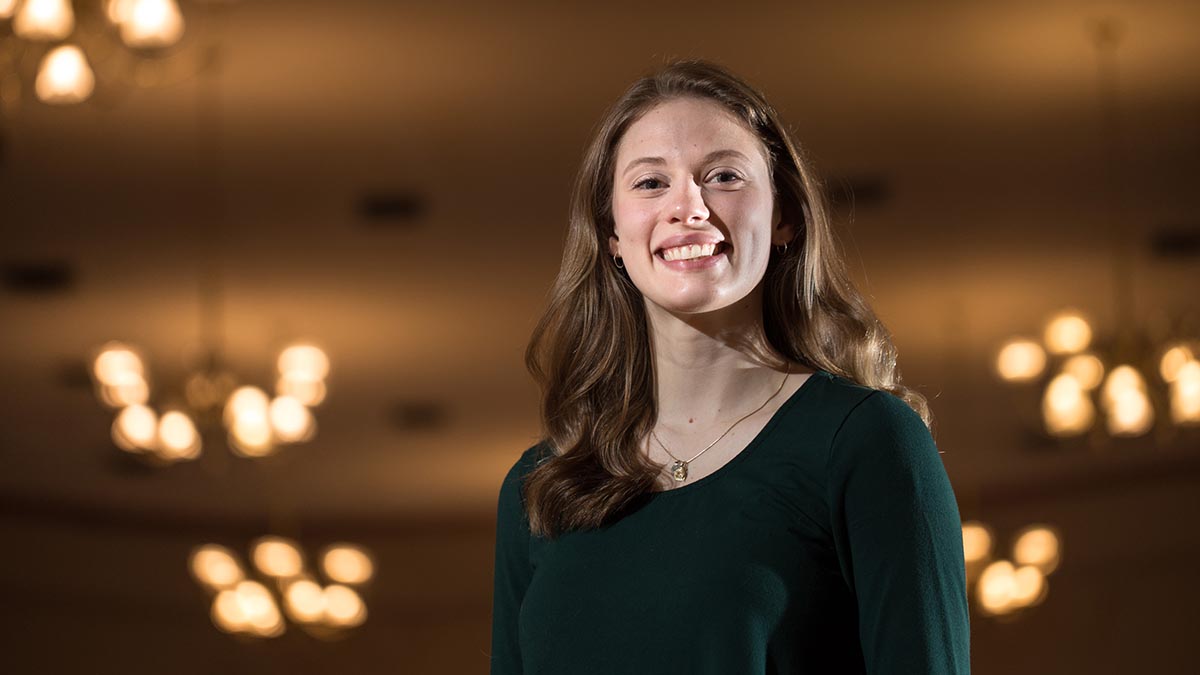Social work major Maria Yates explores community's role in caring for those with mental disorders. She'll present the results of her work April 24 at the Strike a Spark Conference.

5th Annual Strike a Spark Conference
9 a.m.-3:15 p.m. April 24
Convocation Center
Keynote address: Chancellor Daniel Greenstein, 11 a.m., south wing
Live stream, 10:45 a.m.-12:15 p.m.: https://cupmediasite.passhe.edu/Mediasite/Play/57e0c75081eb44b5b1bd9e370c7edb5f1d
It was the stained glass that caught Maria Yates’ attention.
The window, located at The Father’s Heart Ministries, in Penn, Pa., where Yates was working as a residential intern in the addiction recovery program, was a depiction of Dymphna, a saint believed to have the power to cure mental disorders.
Who?
Exactly.
“I thought, ‘Why have I never heard of this?’” said Yates, who is a senior graduating in May with a bachelor’s degree in social work.
With the support of Dr. Azadeh Block in the Department of Social Work, who was the faculty adviser on the project, she dug in to learn more.
Dymphna was a 7th-century princess who fled to Geel, Belgium, to escape her father and devoted her life to serving the mentally disabled. She became a martyr when her father discovered her located and traveled to Geel to behead her.
Today — as it has been for centuries — Geel is known for its de-institutionalization of those with mental disorders. Patients, known as “boarders,” are placed with hosts in the community, providing a sense of belonging and access to family life.
The hosts integrate the boarders into their lives, providing them with food, care and work.
Yates delved into the Geel model of acceptance and integration for a scholarly project she will present April 24 at the 5th Annual Strike a Spark Conference, in the Convocation Center.
The one-day event, sponsored by the Center for Undergraduate Research at Cal U, highlights research, scholarship and creativity.
In her project, “Unwrapping Stigma and Mental Behavioral Health: Lessons from Geel, Belgium,” Yates explored Geel’s acceptance of those with mental illness who are often stigmatized — by themselves, their families or society.
She also visited the National Shrine of St. Dymphna, which is located on the grounds of St. Mary’s Catholic Church in Massillon, Ohio.
The undergraduate research center provided a $500 to Yates for her work.
“I’d like to travel to Geel one day, to try to understand why this model works there — what ingredients make it so the community takes on understanding and empathy.
“There can be a perception that someone with a mental illness just isn’t trying hard enough,” Yates said. “If such stigma isn’t addressed at the public level, it’s hard to make progress.
“The solutions involve a multitude of approaches, including a familial approach. Research is important to learn more about which direction to go.”
Block praised Yates’ dedication and work.
“Maria took a scholarly look at the ways engaging with a family not your own can impact your mental health,” Block said. “She also looked at why such a model didn’t work in the United States.
“She also looked at mental health, which is more about thoughts, and behavioral health, which is more about actions that might impact mental health, and the stigmas around each.
Her project was inclusive of both mental and behavioral health because these terms are often used interchangeably but perhaps the stigma attached to each varies given the values we attach to the terms “behavior” and “mental.”
“Maria was very motivated to take on this project, to engage more deeply with the subject,” Block said. “We’re fortunate to have a research center on campus to promote that.”
